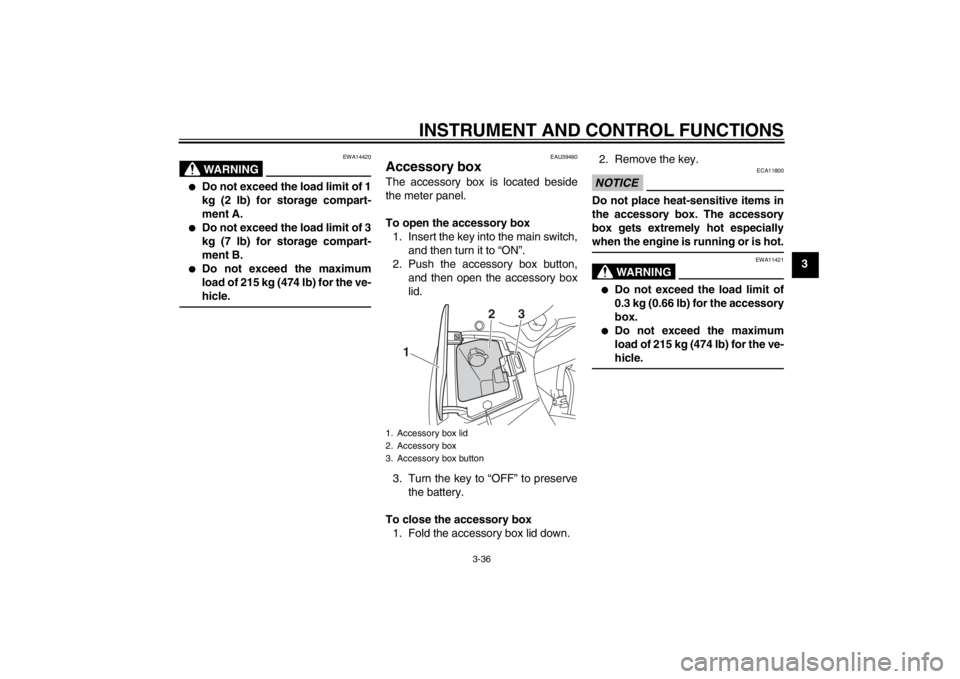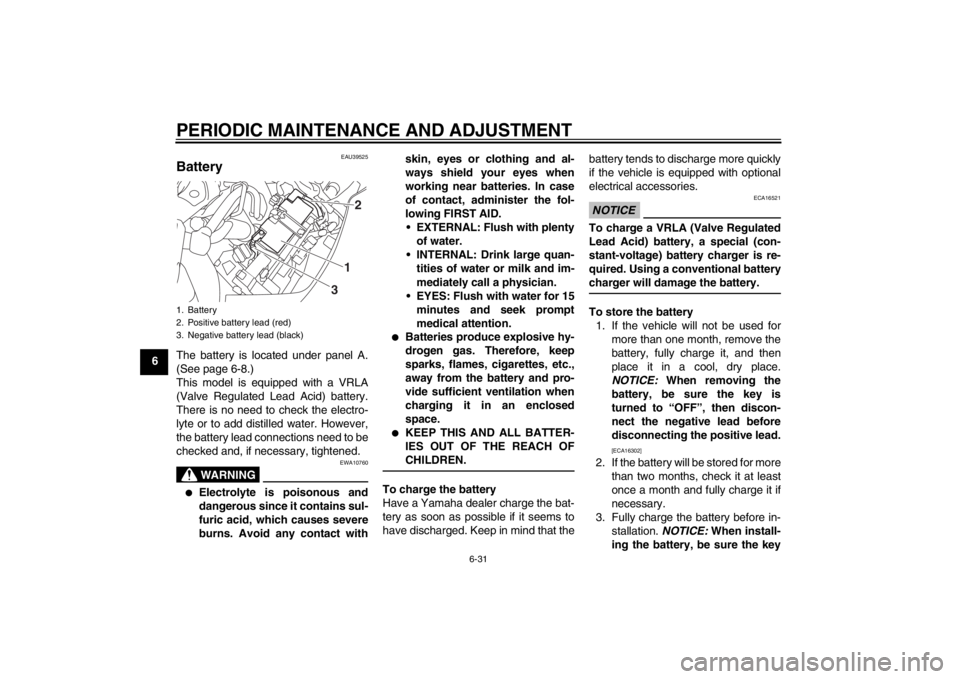Page 7 of 118

TABLE OF CONTENTS
Checking and lubricating the brake and clutch levers ............. 6-27
Checking and lubricating the centerstand and sidestand ........ 6-28
Lubricating the rear suspension ... 6-29
Lubricating the swingarm pivots ... 6-29
Checking the front fork ................. 6-29
Checking the steering ................... 6-30
Checking the wheel bearings ....... 6-30
Battery .......................................... 6-31
Replacing the fuses ...................... 6-32
Headlight bulb .............................. 6-34
Front turn signal light .................... 6-34
Replacing a rear turn signal light
bulb or a tail/brake light bulb ..... 6-34
Replacing the license plate light bulb ........................................... 6-35
Auxiliary light ................................ 6-36
Troubleshooting ............................ 6-36
Troubleshooting charts ................. 6-37
MOTORCYCLE CARE AND
STORAGE .......................................... 7-1
Matte color caution ......................... 7-1
Care ................................................ 7-1
Storage ...........................................7-4
SPECIFICATIONS ............................. 8-1
CONSUMER INFORMATION ............. 9-1
Identification numbers .................... 9-1
U1MCE0E0.book Page 2 Thursday, July 19, 2012 6:59 PM
Page 14 of 118
DESCRIPTION
2-2
2
EAU10420
Right view
8
910116,7
5
3,42
1
1. Storage compartment (page 3-35)
2. Fuel tank cap (page 3-29)
3. Front fork spring preload adjusting bolt (page 3-39)
4. Front fork rebound damping fo rce adjusting knob (page 3-39)
5. Windshield (page 3-12)
6. Fuses (page 6-32)
7. Battery (page 6-31)
8. Front fork compression damping force adjusting screw (page 3-39) 9. Brake pedal (page 3-26)
10.Shock absorber assembly
rebound damping force adjusting knob
(page 3-41)
11.Rear brake fluid reservoir (page 6-24)U1MCE0E0.book Page 2 Thursday, July 19, 2012 6:59 PM
Page 18 of 118
INSTRUMENT AND CONTROL FUNCTIONS
3-3
3To lock the steering
1. Turn the handlebars all the way to
the left or right.
2. Push the key in from the “OFF” po- sition, and then turn it to “LOCK”
while still pushing it.
3. Remove the key. To unlock the steering
Push the key into the main switch, and
then turn it to “OFF” while still pushing
it.
EAU39460
(Parking)
The steering is locked, and the tail-
lights, license plate light and auxiliary
lights are on. The hazard lights and turn
signal lights can be turned on, but all
other electrical systems are off. The
key can be removed.
The steering must be locked before the
key can be turned to “ ”.
NOTICE
ECA11020
Do not use the parking position for
an extended length of time, other-
wise the battery may discharge.
1. Push.
2. Turn.12
1. Push.
2. Turn.12
U1MCE0E0.book Page 3 Thursday, July 19, 2012 6:59 PM
Page 51 of 118

INSTRUMENT AND CONTROL FUNCTIONS
3-36
3
WARNING
EWA14420
●
Do not exceed the load limit of 1
kg (2 lb) for storage compart-
ment A.
●
Do not exceed the load limit of 3
kg (7 lb) for storage compart-
ment B.
●
Do not exceed the maximum
load of 215 kg (474 lb) for the ve-
hicle.
EAU39480
Accessory box The accessory box is located beside
the meter panel.
To open the accessory box1. Insert the key into the main switch, and then turn it to “ON”.
2. Push the accessory box button, and then open the accessory box
lid.
3. Turn the key to “OFF” to preserve the battery.
To close the accessory box 1. Fold the accessory box lid down. 2. Remove the key.
NOTICE
ECA11800
Do not place heat-sensitive items in
the accessory box. The accessory
box gets extremely hot especially
when the engine is running or is hot.
WARNING
EWA11421
●
Do not exceed the load limit of
0.3 kg (0.66 lb) for the accessory
box.
●
Do not exceed the maximum
load of 215 kg (474 lb) for the ve-
hicle.
1. Accessory box lid
2. Accessory box
3. Accessory box button
1
2
3
U1MCE0E0.book Page 36 Thursday, July 19, 2012 6:59 PM
Page 60 of 118

INSTRUMENT AND CONTROL FUNCTIONS
3-45
3
EAU39655
Auxiliary DC jack
WARNING
EWA14360
To prevent electrical shock or short-
circuiting, make sure that the cap is
installed when the auxiliary DC jack
is not being used.NOTICE
ECA15431
The accessory connected to the
auxiliary DC jack should not be used
with the engine turned off, and the
load must never exceed 30 W (2.5 A),
otherwise the fuse may blow or the
battery may discharge.This vehicle is equipped with an auxilia-
ry DC jack in the accessory box.
A 12-V accessory connected to the
auxiliary jack can be used when the key
is in the “ON” position and should only
be used when the engine is running.
To use the auxiliary DC jack1. Open the accessory box lid. (See page 3-36.)
2. Turn the key to “OFF”.
3. Remove the auxiliary DC jack cap. 4. Turn the accessory off.
5. Insert the accessory plug into the
auxiliary DC jack.
6. Turn the key to “ON”, and then start the engine. (See page 5-1.)
7. Turn the accessory on.
1. Auxiliary DC jack cap
1. Auxiliary DC jack
11
U1MCE0E0.book Page 45 Thursday, July 19, 2012 6:59 PM
Page 65 of 118

OPERATION AND IMPORTANT RIDING POINTS
5-2
5
NOTICE
ECA11833
If a warning or indicator light does
not come on initially when the key is
turned to “ON”, or if a warning or in-
dicator light remains on, see page
3-4 for the corresponding warning
and indicator light circuit check.
The ABS warning light should
come on when the key is turned to
“ON”, and then go off after travel-
ing at a speed of 10 km/h (6 mi/h)
or higher.
NOTICE
ECA17681
If the ABS warning light does not
come on and then go off as ex-
plained above, see page 3-4 for the
warning light circuit check.2. Shift the transmission into the neu-tral position. The neutral indicator
light should come on. If not, ask a
Yamaha dealer to check the elec- trical circuit.
3. Start the engine by pushing the “ ” side of the start/engine
stop switch. If the engine fails to start, release
the start/engine stop switch, wait a
few seconds, and then try again.
Each starting attempt should be as
short as possible to preserve the
battery. Do not crank the engine
more than 10 seconds on any one
attempt.
NOTICE
ECA11042
For maximum engine life, never ac-
celerate hard when the engine is
cold!
EAU16671
Shifting Shifting gears lets you control the
amount of engine power available for
starting off, accelerating, climbing hills,
etc.
The gear positions are shown in the il-
lustration.TIPTo shift the transmission into the neu-
tral position, press the shift pedal down
repeatedly until it reaches the end of its
travel, and then slightly raise it.1. Shift pedal
2. Neutral position
U1MCE0E0.book Page 2 Thursday, July 19, 2012 6:59 PM
Page 98 of 118

PERIODIC MAINTENANCE AND ADJUSTMENT
6-31
6
EAU39525
Battery The battery is located under panel A.
(See page 6-8.)
This model is equipped with a VRLA
(Valve Regulated Lead Acid) battery.
There is no need to check the electro-
lyte or to add distilled water. However,
the battery lead connections need to be
checked and, if necessary, tightened.
WARNING
EWA10760
●
Electrolyte is poisonous and
dangerous since it contains sul-
furic acid, which causes severe
burns. Avoid any contact withskin, eyes or clothing and al-
ways shield your eyes when
working near batteries. In case
of contact, administer the fol-
lowing FIRST AID.
EXTERNAL: Flush with plenty of water.
INTERNAL: Drink large quan- tities of water or milk and im-
mediately call a physician.
EYES: Flush with water for 15 minutes and seek prompt
medical attention.
●
Batteries produce explosive hy-
drogen gas. Therefore, keep
sparks, flames, cigarettes, etc.,
away from the battery and pro-
vide sufficient ventilation when
charging it in an enclosed
space.
●
KEEP THIS AND ALL BATTER-
IES OUT OF THE REACH OF
CHILDREN.
To charge the battery
Have a Yamaha dealer charge the bat-
tery as soon as possible if it seems to
have discharged. Keep in mind that the battery tends to discharge more quickly
if the vehicle is equipped with optional
electrical accessories.
NOTICE
ECA16521
To charge a VRLA (Valve Regulated
Lead Acid) battery, a special (con-
stant-voltage) battery charger is re-
quired. Using a conventional battery
charger will damage the battery.To store the battery
1. If the vehicle will not be used for more than one month, remove the
battery, fully charge it, and then
place it in a cool, dry place.
NOTICE: When removing the
battery, be sure the key is
turned to “OFF”, then discon-
nect the negative lead before
disconnecting the positive lead.
[ECA16302]
2. If the battery will be stored for more than two months, check it at least
once a month and fully charge it if
necessary.
3. Fully charge the battery before in- stallation. NOTICE: When install-
ing the battery, be sure the key
1. Battery
2. Positive battery lead (red)
3. Negative battery lead (black)
1 2
3
U1MCE0E0.book Page 31 Thursday, July 19, 2012 6:59 PM
Page 99 of 118
![YAMAHA FJR1300A 2013 Owners Manual PERIODIC MAINTENANCE AND ADJUSTMENT
6-32
6
is turned to “OFF”, then con-
nect the positive lead before
connecting the negative lead.
[ECA16840]
4. After installation, make sure that
the battery le YAMAHA FJR1300A 2013 Owners Manual PERIODIC MAINTENANCE AND ADJUSTMENT
6-32
6
is turned to “OFF”, then con-
nect the positive lead before
connecting the negative lead.
[ECA16840]
4. After installation, make sure that
the battery le](/manual-img/51/49533/w960_49533-98.png)
PERIODIC MAINTENANCE AND ADJUSTMENT
6-32
6
is turned to “OFF”, then con-
nect the positive lead before
connecting the negative lead.
[ECA16840]
4. After installation, make sure that
the battery leads are properly con-
nected to the battery terminals.NOTICE
ECA16530
Always keep the battery charged.
Storing a discharged battery can
cause permanent battery damage.
EAU54510
Replacing the fuses The fuse boxes and individual fuses are
located under panel A. (See page 6-8.)
If a fuse is blown, replace it as follows.1. Turn the key to “OFF” and turn off the electrical circuit in question.1. Main fuse 1
2. Spare fuse
3. Cruise control fuse
4. Brake light fuse
5. Fuse box
6. Main fuse 2
5
1
3
4
2
2
5
26
1. ABS motor fuse
2. ABS solenoid fuse
3. Fuel injection system fuse
4. Backup fuse (for clock and immobilizer sys-
tem)
5. Electronic throttle valve fuse
6. Headlight fuse
7. Spare fuse
8. Hazard fuse
9. Signaling system fuse
10.Auxiliary DC jack fuse
11.ABS control unit fuse
12.Ignition fuse
13.Right radiator fan fuse
14.Left radiator fan fuse
15.Windshield motor fuse
147
9101112
13
715
817
2
3456
7
U1MCE0E0.book Page 32 Thursday, July 19, 2012 6:59 PM